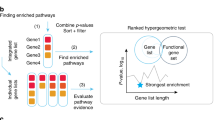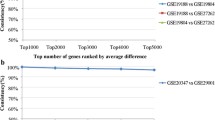Abstract
In order to identify genes whose expression is associated with resistance to the chemotherapeutic agent oxaliplatin, transcripts differentially expressed between an oxaliplatin sensitive and a stably resistant subline were compared in six independent replicates using Stanford cDNA microarrays for five cell lines. “Significance analysis of microarrays” (SAM) was used to identify genes whose expression was statistically significantly different in the sensitive versus resistant members of each cell line pair. The biochemical pathways of the Kyoto Encyclopedia of Genes and Genomes (KEGG) database were searched to identify those pathways in which the number of SAM-identified genes exceeded the number expected. This identified four pathways in which upregulated genes were significantly associated with resistance in two of the cell line pairs, and two pathways in which the association was found in three cell line pairs. The search also identified 12 pathways in which downregulated genes were associated with resistance in two cell line pairs and one pathway in which the association reached statistical significance in three cell line pairs. Pathways identified included the ribosome pathway, the Huntington’s disease pathway that includes caspase 8, and the ATP synthesis pathways. Determination of the chromosomal location of each SAM-identified gene revealed several locales within which genes lay in close proximity, including three genes (APACD, IF-2, and REV1L) located on chromosome 2 that lie immediately adjacent to each other and were significantly upregulated in three of five cell line pairs. Biochemical pathway and chromosomal mapping of genes identified by SAM as differentially expressed in related cell line pairs points to mechanisms and chromosomal sites not previously suspected of association with the oxaliplatin-resistant phenotype.





Similar content being viewed by others
Abbreviations
- APACD:
-
ATP binding protein associated with cell differentiation
- IF-2:
-
Translation initiation factor IF2
- KEGG:
-
Kyoto Encyclopedia of Genes and Genomes
- SAM:
-
Significance analysis of microarrays
References
Alberch J, Perez-Navarro E, Canals JM (2004) Neurotrophic factors in Huntington’s disease. Prog Brain Res 146:195
Andrews PA, Albright KD (1992) Mitochondrial defects in cis-diamminedichloroplatinum(Ii) resistant human ovarian carcinoma cells. Cancer Res 52:1895
Cariello NF, Swenberg JA, Skopek TR (1992) In vitro mutational specificity of cisplatin in the human hypoxanthine guanine phosphoribosyltransferase gene. Cancer Res 52:2866
Desoize B, Madoulet C (2002) Particular aspects of platinum compounds used at present in cancer treatment. Crit Rev Oncol Hematol 42:317
Diehn M, Sherlock G, Binkley G, Jin H, Matese JC, Hernandez-Boussard T, Rees CA, Cherry JM, Botstein D, Brown PO, Alizadeh AA (2003) SOURCE: a unified genomic resource of functional annotations, ontologies, and gene expression data. Nucleic Acids Res 31:219
Eisen MB, Spellman PT, Brown PO, Botstein D (1998) Cluster analysis and display of genome-wide expression patterns. Proc Natl Acad Sci U S A 95:14863
Friedberg EC, Feaver WJ, Gerlach VL (2000) The many faces of DNA polymerases: strategies for mutagenesis and for mutational avoidance. Proc Natl Acad Sci U S A 97:5681
Gourdier I, Del Rio M, Crabbe L, Candeil L, Copois V, Ychou M, Auffray C, Martineau P, Mechti N, Pommier Y, Pau B (2002) Drug specific resistance to oxaliplatin is associated with apoptosis defect in a cellular model of colon carcinoma. FEBS Lett 529:232
Isonishi S, Saitou M, Yasuda M, Tanaka T (2001) Mitochondria in platinum resistant cells. Hum Cell 14:203
Johnson RE, Washington MT, Prakash S, Prakash L (1999) Bridging the gap: a family of novel DNA polymerases that replicate faulty DNA. Proc Natl Acad Sci U S A 96:12224
Johnsson A, Byrne P, de Bruin R, Weiner D, Wong J, Los G (2001) Identification of gene clusters differentially expressed during the cellular injury responses (CIR) to cisplatin. Br J Cancer 85:1206
Lawrence CW (2002) Cellular roles of DNA polymerase zeta and Rev1 protein. DNA Repair 1:425
Lin X, Howell SB (2002) The role of DNA polymerase zeta in cisplatin resistance. Proc Am Assoc Cancer Res 43:425
Lin X, Okuda T, Holzer A, Howell SB (2002) The copper transporter CTR1 regulates cisplatin uptake in Saccharomyces cerevisiae. Mol Pharmacol 62:1154
Louro H, Silva MJ, Boavida MG (2002) Mutagenic activity of cisplatin in the lacZ plasmid-based transgenic mouse model. Environ Mol Mutagen 40:283
Mishima M, Samimi G, Kondo A, Lin X, Howell SB (2002) The cellular pharmacology of oxaliplatin resistance. Eur J Cancer 38:1405
Misset JL, Bleiberg H, Sutherland W, Bekradda M, Cvitkovic E (2000) Oxaliplatin clinical activity: a review. Crit Rev Oncol Hematol 35:75
Pendyala L, Creaven PJ (1993) In vitro cytotoxicity, protein binding, red blood cell partitioning, and biotransformation of oxaliplatin. Cancer Res 53:5970
Raymond E, Chaney SG, Taamma A, Cvitkovic E (1999) Oxaliplatin: a review of preclinical and clinical studies. Ann Oncol 10:1053
Rixe O, Ortuzar W, Alvarez M, Parker R, Reed E, Paull K, Fojo T (1996) Oxaliplatin, tetraplatin, cisplatin, and carboplatin: spectrum of activity in drug-resistant cell lines and in the cell lines of the National Cancer Institute’s Anticancer Drug Screen panel. Biochem Pharmacol 52:1855
Storey JD, Tibshirani R (2003) SAM thresholding and false discovery rates for detecting differential gene expression in DNA microarrays. In: Parmigiani G, Garrett ES, Irizarry RA, Zeber SL (eds) The analysis of gene expression data: methods and software. Springer, New York
Tusher VG, Tibshirani R, Chu G (2001) Significance analysis of microarrays applied to the ionizing radiation response. Proc Natl Acad Sci U S A 98:5116
Yang Y, Dudoit S, Luu P, Lin D, Peng V, Ngai J, Speed T (2002) Normalization for cDNA microarray data: a robust composite method addressing single and multiple slide systematic variation. Nucleic Acids Res 30:e15
Acknowledgements
The authors express their appreciation to Dr John Weinstein, Donna Pauler and John Crowley for helpful discussions and to Dr Bernard Palsson for use of the scanner. We would also like to thank Michael Fero and the staff of the Stanford Functional Genomics Facility for supplying us with the human cDNA microarrays used for this study. Supported by a grant from Sanofi-Synthelabo Inc., and in part by grants CA78648 and CA95298 from the National Institutes of Health.
Author information
Authors and Affiliations
Corresponding author
Rights and permissions
About this article
Cite this article
Samimi, G., Manorek, G., Castel, R. et al. cDNA microarray-based identification of genes and pathways associated with oxaliplatin resistance. Cancer Chemother Pharmacol 55, 1–11 (2005). https://doi.org/10.1007/s00280-004-0819-9
Received:
Accepted:
Published:
Issue Date:
DOI: https://doi.org/10.1007/s00280-004-0819-9




